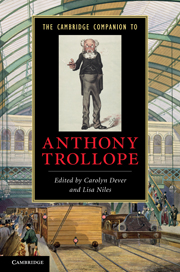Book contents
- Frontmatter
- Introduction
- 1 Trollope’s Literary Life and Times
- 2 Trollope As Autobiographer And Biographer
- 3 Trollope’s Barsetshire Series
- 4 The Palliser Novels
- 5 Trollope Redux: The Later Novels
- 6 Trollope’s Short Fiction
- 7 Trollope And The Sensation Novel
- 8 Queer Trollope
- 9 The hobbledehoy in Trollope
- 10 The construction of masculinities
- 11 Vulgarity and money
- 12 Trollope and the law
- 13 Trollope and travel
- 14 Trollope and the Antipodes
- 15 Trollope and Ireland
- 16 Trollope and America
- Further reading
- Index
- Cambridge Companions to . . .
16 - Trollope and America
Published online by Cambridge University Press: 28 March 2011
- Frontmatter
- Introduction
- 1 Trollope’s Literary Life and Times
- 2 Trollope As Autobiographer And Biographer
- 3 Trollope’s Barsetshire Series
- 4 The Palliser Novels
- 5 Trollope Redux: The Later Novels
- 6 Trollope’s Short Fiction
- 7 Trollope And The Sensation Novel
- 8 Queer Trollope
- 9 The hobbledehoy in Trollope
- 10 The construction of masculinities
- 11 Vulgarity and money
- 12 Trollope and the law
- 13 Trollope and travel
- 14 Trollope and the Antipodes
- 15 Trollope and Ireland
- 16 Trollope and America
- Further reading
- Index
- Cambridge Companions to . . .
Summary
The Trollope family made something of an industry of visiting America and writing about it. In the late 1820s, Frances Trollope had gone to America in the hope of reviving the Trollope family fortunes. After trying and failing to establish a business on the western frontier, she decided to become an author instead. She first published a book about her American travels, The Domestic Manners of the Americans (1832), and then a novel, The Refugee in America (1832), and the success of these launched her on a prolific career. A generation later, Anthony Trollope would visit America four times. He stopped off briefly in the late 1850s after touring the West Indies, and he paid a more substantial visit in 1861, in order to write an American travel book of his own, North America (1862). He subsequently gave a public lecture in London about his experiences. In 1868, he returned to America in an official capacity, negotiating a new treaty for postal rates, and in 1875 he visited America a final time, crossing the continent from west to east at the end of his tour of the Pacific and publishing an essay about California in the process. America and Americans are also a frequent topic in his fiction. In addition to several short stories from the early 1860s, three of Trollope’s later novels focus on America. The most memorable of these, perhaps, is The Way We Live Now (1874–75), which is set in a London entirely upended by two visitors from the American West, the speculator Hamilton K. Fisker and Mrs. Hurtle, an adventuress. Another novel, The American Senator (1876–77), follows the adventures of one Elias Gotobed, senator from the fictional state of Mikewa, as he makes his way through the English countryside, commenting on all that he sees. And the final chapters of a late novel, Dr.Wortle’s School (1881), are set in America, as a young Englishman travels to California in search of a desperado who is threatening him and his wife.
- Type
- Chapter
- Information
- The Cambridge Companion to Anthony Trollope , pp. 210 - 223Publisher: Cambridge University PressPrint publication year: 2010
- 1
- Cited by

